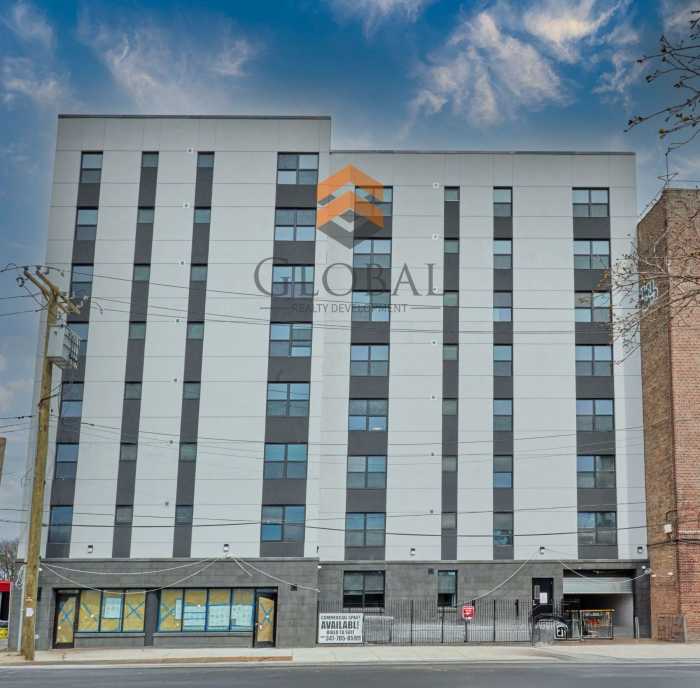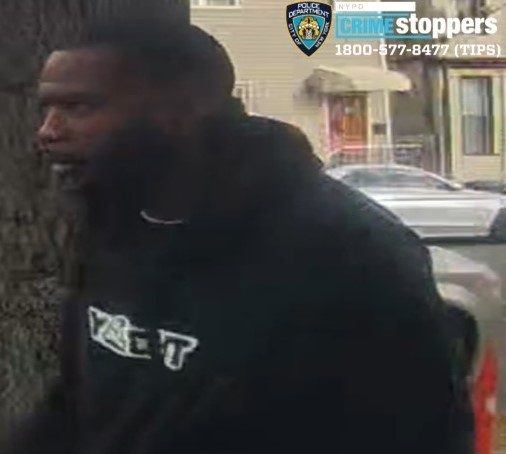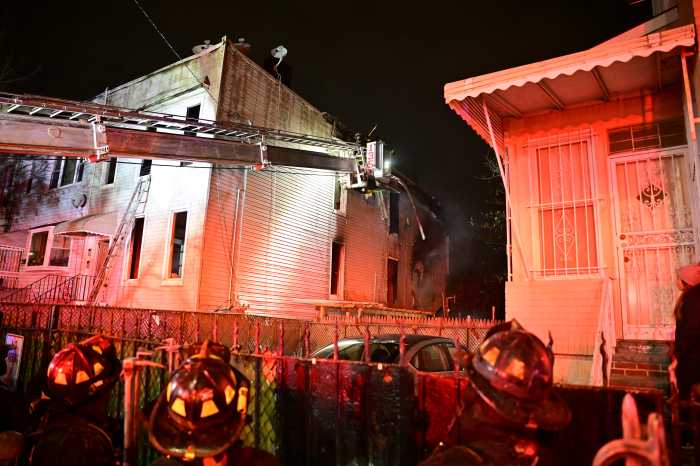By JERRY TALLMER
As a Yellow Cab succumbs to flames, the Ohio closes its doors
On the evening of August 14, the ancient and honorable Ohio Theatre (at 66 Wooster St., in the heart of Soho) is going up in flames.
Not literally. Metaphorically. With a New York City Yellow Cab bursting into fire on stage. Not literally. Metaphorically. A tiny little Yellow Cab — like the dollhouse mansion within the large imaginary mansion in Edward Albee’s “Tiny Alice.” But it might just as well be literally — because with the last line and moment of Robert Lyons’ “Nostradamus Predicts the Death of Soho” (following a $100-a-head party), the Ohio closes its doors forever as a theater and becomes…well, who knows? A pizza palace? A fancy bootery? A perfumerie? Whatever the traffic will bear.
Big, tall, sturdy, white-haired Robert Lyons — the playwright and director who has been running the Ohio for 22 years now (first as general manager, then, since 1994, as founder and prime mover of the not-for-profit producing unit called Soho Think Tank) — is anything but downcast.
Though his “Nostradamus” play gets four performances only, he’s looking forward to a new theatrical life in residence at 3LD (3-Legged Dog) — Kevin Cunningham’s double-duty, technologically up-to-date big and small theater spaces at Greenwich and Rector Streets (just below what used to be the World Trade Center).
“Kevin Cunningham reached out to me,” says the grateful Lyons — whose annual summer theatrical festival was and is dubbed The Ice Factory “because we didn’t have air conditioning 17 years ago, and still don’t.” Now they will.
In a production note, playwright Lyons tells us his “Nostradamus Predicts the Death of Soho” was inspired by German Expressionist drama of the 1920s. I myself would say, rather, that it bespeaks the romantic symbolism of 1920s works like Edna St. Vincent Millay’s “Aria da Capo.”
There are four characters, or three really, or only one really, depending on how you look at it. At the center is Marsha (actress Annie Scott) — a confused young woman who works as a model in a run-down wedding dress shop window somewhere in Soho (and who did or did not see a Yellow Cab burst into flame, depending).
It is perhaps also only in her head that there exists the other three, or two, characters.
One is her apartment mate Buster (Clayton Dean Smith), an overbearing computer-mad nutcase whose delusion is that he will cybernetically take over the minds, hearts and economic goods of all the humans in this world.
Then there is a character identified only as The Actor (and played by real-life actor Alan Benditt), who has the hots for Marsha and deep dislike of bullying Buster. Halfway through the proceedings, this Actor is charred to a crisp along with the Yellow Cab — but he continues playing right along, coated in soot, romantically pursuing Marsha.
But whenever The Actor leaves the apartment, he immediately morphs into the fourth character, a nameless blind old panhandler who follows Marsha around whether she likes it or not, and who has the gift of prophecy — which is of course how Nostradamus (1503-1566) gets into the picture.
Back when he wrote this play — the last in a trilogy (the first two being “Doorman Double Duty” and “Red-Haired Thomas,” both about urban insecurity) — did Robert Lyons know the Ohio Theatre was under a death sentence?
“No,” he says. “Though when I did write it, a year and a half ago, I knew something was in the air. I’d had that ‘Nostradamus’ title in my mind for about five years. Didn’t know how it would turn out. At one point, Nostradamus was a character in the play. Now he’s not. It went from a literal idea to more of a metaphor.
“In the prophecies of Nostradamus there’s a specific Canto IX in which some people say he predicted 9/11. But there’s a whole other faction that says, no, Canto IX refers to a Russian satellite filled with plutonium that almost crashed into the earth in the 1990s. So did Nostradamus have the power to predict near misses? Did Canto IX predict 9/11, which happened, or this other thing that didn’t happen?”
And how does all that — and Buster, and The Actor, and the blind panhandler, and the burning taxicab, and a computer tossed into the drink, get into the head of poor messed up Marsha? The play doesn’t quite tell you. It lets you guess.
Central to the piece is the ongoing war between Marsha and Buster as to whether this is her apartment (though Buster’s paying the rent) or his office.
“I think it’s a common contemporary situation,” says the playwright/director — who lives in the West Village with his wife Lenora Champagne and their daughter Amelie. Ms. Champagne is herself a playwright and director whose “Staying Afloat” opened this summer’s Ice Factory Festival a month ago. Fifteen-year-old Amelie is — guess what! — an actress and playwright.
Robert Lyons was born July 6, 1959, in Detroit, Michigan, and grew up in a suburb of the Motor City. His father was a white-collar worker at Chrysler, his mother a secretary in the school system.
His first pointed exposure to theater — after graduation from Michigan State with a BA in English — came “when bumming around the East Coast as a poet and short-story writer.” In Gloucester, Massachusetts, he happened onto a theater company doing a play by Gloucester and Greenwich Village’s Israel Horovitz, and his goose was cooked. It was signed and sealed, so to speak, as an intern under Murphy Goyer.
“I watched what he did, and said to myself: ‘I’d like to do what he does.’” Now, after 22 years at 66 Wooster Street, Robert Lyons will be doing it at 3LD (Greenwich and Rector Streets). And he won’t be singing: “Why, oh why, oh why-oh, why did I leave Ohio?”
Water under the bridge. The Ohio may be gone, but Soho lives. For Robert Lyons, it’s just moved a dozen blocks south.

































